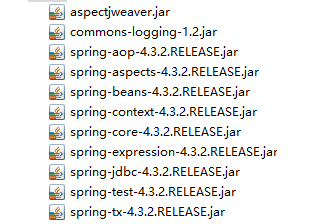引言
.SSM是什么?
SSM是指目前最主流的项目架构的三大框架:
SpringMVC : spring的 Web层框架,是spring的一个模块
Spring :容器框架
MyBatis :持久层框架
2.spring与mybatis集成示例
我们集成mybatis和spring,主要是为了让mybatis用spring的事务管理
2.1 相关导入jar包
Spring依赖包:

mybatis依赖包:

MyBatis和Spring框架集成的桥梁包:
Spring自己并没有集成MyBatis框架,而是有MyBatis自己来集成,所以还需要Spring框架集成的桥梁包

数据库驱动包和连接池:


Mybatis支持的日志包log4j:

2.2 项目整体结构

2.3 Mapper层

package com.gjs.ssm.mapper;
import java.util.List;
import com.gjs.ssm.pojo.User;
public interface UserMapper {
public int insert(User user);
public User selectByPrimaryKey(Integer id);
public List<User> selectList();
public int delteByPrimaryKey(Integer id);
}

Mapper.xml文件

<?xml version="1.0" encoding="UTF-8" ?>
<!DOCTYPE mapper
PUBLIC "-//mybatis.org//DTD Mapper 3.0//EN"
"http://mybatis.org/dtd/mybatis-3-mapper.dtd">
<mapper namespace="com.gjs.ssm.mapper.UserMapper">
<insert id="insert" parameterType="com.gjs.ssm.pojo.User">
insert into user (name,password,age)values(#{name},#{password},#{age})
</insert>
<select id="selectByPrimaryKey" parameterType="Integer" resultType="com.gjs.ssm.pojo.User">
select * from user where id = #{id}
</select>
<select id="selectList" resultType="com.gjs.ssm.pojo.User">
select * from user
</select>
<delete id="delteByPrimaryKey" parameterType="int">
delete from user where id = #{id}
</delete>
</mapper>

2.4 Service层

package com.gjs.ssm.service.impl;
import java.util.List;
import org.springframework.beans.factory.annotation.Autowired;
import org.springframework.stereotype.Service;
import com.gjs.ssm.mapper.UserMapper;
import com.gjs.ssm.pojo.User;
import com.gjs.ssm.service.UserService;
@Service
public class UserSerivceImpl implements UserService{
@Autowired
UserMapper userMapper;
@Override
public int inset(User user) {
return userMapper.insert(user);
}
@Override
public User selectByPrimaryKey(Integer id) {
return userMapper.selectByPrimaryKey(id);
}
@Override
public List<User> selectList() {
return userMapper.selectList();
}
@Override
public int delteByPrimaryKey(Integer id) {
return userMapper.delteByPrimaryKey(id);
}
}

2.5层与层之间(Mapper和Service)spring对象的创建和依赖关系的维护(A)
之前我们Mapper对象的创建是通过sqlSession对象创建的,sqlSession对象又是SqlSessionFactory对象创建出来的,而SqlSessionFactory对象是通过读取配置文件中的相关配置创建的。
所谓的spring与mybatis集成,说白了就是把这些对象的创建都交给spring来处理。那怎么让spring自己创建这些对象呢?
spring-mybatis桥梁包中提供的org.mybatis.spring.SqlSessionFactoryBean类可以创建SqlSessionFactory对象,org.mybatis.spring.mapper.MapperScannerConfigurer类可以用来创建 Mapper接口的代理对象。所以只要在spring中配置这两个对象并注入依赖即可。具体配置如下:
spring.xml:

<?xml version="1.0" encoding="UTF-8"?>
<beans xmlns="http://www.springframework.org/schema/beans"
xmlns:p="http://www.springframework.org/schema/p"
xmlns:context="http://www.springframework.org/schema/context"
xmlns:aop="http://www.springframework.org/schema/aop"
xmlns:tx="http://www.springframework.org/schema/tx"
xmlns:xsi="http://www.w3.org/2001/XMLSchema-instance"
xsi:schemaLocation="
http://www.springframework.org/schema/beans
http://www.springframework.org/schema/beans/spring-beans.xsd
http://www.springframework.org/schema/context
http://www.springframework.org/schema/context/spring-context.xsd
http://www.springframework.org/schema/aop
http://www.springframework.org/schema/aop/spring-aop.xsd
http://www.springframework.org/schema/tx
http://www.springframework.org/schema/tx/spring-tx.xsd
">
<!-- 开启注解包扫描 -->
<context:component-scan base-package="com.gjs.ssm"/>
<!-- 读取db.properties 配置文件 -->
<context:property-placeholder location="classpath:db.properties"/>
<!-- 配置druid连接池 -->
<bean id="dataSource" class="com.alibaba.druid.pool.DruidDataSource">
<property name="driverClassName" value="${jdbc.driverClassName}"/>
<property name="url" value="${jdbc.url}"/>
<property name="username" value="${jdbc.username}"/>
<property name="password" value="${jdbc.password}"/>
<property name="maxActive" value="${jdbc.maxActive}"/>
</bean>
<!-- 配置SqlSessionFactoryBean对象 -->
<bean name="sqlSessionFactory" class="org.mybatis.spring.SqlSessionFactoryBean">
<!-- 注入数据源 -->
<property name="dataSource" ref="dataSource"/>
<!-- 配置映射文件 -->
<property name="mapperLocations">
<array>
<value>classpath:com/gjs/ssm/mapper/*Mapper.xml</value>
</array>
</property>
<!-- 配置包扫描的别名 -->
<property name="typeAliasesPackage" value="com.gjs.ssm.pojo"/>
<!--
如果需要读取mybatis框架的配置文件mybat-config.xml可使用:
<property name="configLocation" value="classpath:mybatis-config.xml"/>
不过一般不需要
-->
</bean>
<!-- SqlSession对象的创建只需通过sqlSessionFactory对象调用openSession()方法即可,spring会自动创建 -->
<!-- 使用包扫描批量创建 Mapper接口对应的代理对象 -->
<bean class="org.mybatis.spring.mapper.MapperScannerConfigurer">
<!-- 配置包扫描创建代理对象的位置 -->
<property name="basePackage" value="com.gjs.ssm.mapper"/>
<!-- 注入sqlSessionFactory bean的名称 -->
<property name="sqlSessionFactoryBeanName" value="sqlSessionFactory"/>
</bean>
<!-- 配置事务管理器 -->
<bean id="txManager" class="org.springframework.jdbc.datasource.DataSourceTransactionManager">
<!-- 注入数据源 -->
<property name="dataSource" ref="dataSource"/>
</bean>
<!-- 配置事务通知 -->
<tx:advice id="txAdvice" transaction-manager="txManager">
<tx:attributes>
<!-- DQL -->
<tx:method name="select*" read-only="true" isolation="REPEATABLE_READ" propagation="REQUIRED"/>
<tx:method name="get*" read-only="true" isolation="REPEATABLE_READ" propagation="REQUIRED"/>
<tx:method name="find*" read-only="true" isolation="REPEATABLE_READ" propagation="REQUIRED"/>
<tx:method name="query*" read-only="true" isolation="REPEATABLE_READ" propagation="REQUIRED"/>
<!-- 非DQL -->
<tx:method name="*" read-only="false" isolation="REPEATABLE_READ" propagation="REQUIRED"/> </tx:attributes>
</tx:advice>
<!-- 使用AOP将事务切入到service层 -->
<aop:config >
<!-- 切入点 -->
<aop:pointcut expression="execution(* com.gjs.ssm.service..*.*(..))" id="pt"/>
<!-- 切面 = 切入点+通知-->
<aop:advisor advice-ref="txAdvice" pointcut-ref="pt"/>
<!-- Spring 负责织入 -->
</aop:config>
</beans>

下面这段代码是其中的关键

<!-- 配置SqlSessionFactoryBean对象 -->
<bean name="sqlSessionFactory" class="org.mybatis.spring.SqlSessionFactoryBean">
<!-- 注入数据源 -->
<property name="dataSource" ref="dataSource"/>
<!-- 配置映射文件 -->
<property name="mapperLocations">
<array>
<value>classpath:com/gjs/ssm/mapper/*Mapper.xml</value>
</array>
</property>
<!-- 配置包扫描的别名 -->
<property name="typeAliasesPackage" value="com.gjs.ssm.pojo"/>
<!--
如果需要读取mybatis框架的配置文件mybat-config.xml可使用:
<property name="configLocation" value="classpath:mybatis-config.xml"/>
不过一般不需要
-->
</bean>
<!-- SqlSession对象的创建只需通过sqlSessionFactory对象调用openSession()方法即可,spring会自动创建 -->
<!-- 使用包扫描批量创建 Mapper接口对应的代理对象 -->
<bean class="org.mybatis.spring.mapper.MapperScannerConfigurer">
<!-- 配置包扫描创建代理对象的位置 -->
<property name="basePackage" value="com.gjs.ssm.mapper"/>
<!-- 注入sqlSessionFactory bean的名称 -->
<property name="sqlSessionFactoryBeanName" value="sqlSessionFactory"/>
</bean>

2. 5 测试代码

package com.gjs.ssm.test;
import java.util.List;
import org.junit.Test;
import org.junit.runner.RunWith;
import org.springframework.beans.factory.annotation.Autowired;
import org.springframework.test.context.ContextConfiguration;
import org.springframework.test.context.junit4.SpringJUnit4ClassRunner;
import com.gjs.ssm.pojo.User;
import com.gjs.ssm.service.UserService;
@RunWith(SpringJUnit4ClassRunner.class)
@ContextConfiguration("classpath:spring.xml")
public class UserSerivceImplTest {
@Autowired
private UserService userService;
@Test
public void testInset() {
User user = new User(null, "张三", "123", 30);
int row = userService.inset(user);
System.out.println(row);
}
@Test
public void testSelectByPrimaryKey() {
User user = userService.selectByPrimaryKey(3);
System.out.println(user);
}
@Test
public void testSelectList() {
List<User> selectList = userService.selectList();
System.out.println(selectList);
}
@Test
public void testDelteByPrimaryKey() {
int row = userService.delteByPrimaryKey(3);
System.out.println(row);
}
}

3.SpringMVC的集成
3.1 导入相关jar包
SpringMVC依赖包:

Jstl标签库依赖包:

3.2 项目整体结构

3.3 springmvc.xml配置文件

<?xml version="1.0" encoding="UTF-8"?>
<beans xmlns="http://www.springframework.org/schema/beans"
xmlns:p="http://www.springframework.org/schema/p"
xmlns:mvc="http://www.springframework.org/schema/mvc"
xmlns:xsi="http://www.w3.org/2001/XMLSchema-instance"
xsi:schemaLocation="
http://www.springframework.org/schema/beans
http://www.springframework.org/schema/beans/spring-beans.xsd
http://www.springframework.org/schema/mvc
http://www.springframework.org/schema/mvc/spring-mvc.xsd
">
<!-- 开启springMVC注解驱动 -->
<mvc:annotation-driven/>
</beans>

3.4 编写控制器

package com.gjs.ssm.controller;
import java.util.List;
import org.springframework.beans.factory.annotation.Autowired;
import org.springframework.stereotype.Controller;
import org.springframework.ui.Model;
import org.springframework.web.bind.annotation.RequestMapping;
import com.gjs.ssm.pojo.User;
import com.gjs.ssm.service.UserService;
@Controller
@RequestMapping("/user")
public class UserController {
@Autowired
private UserService userService;
@RequestMapping("/list")
public String list(Model model) {
List<User> users = userService.selectList();
model.addAttribute("users", users);
return "/WEB-INF/view/user_list.jsp";
}
}

3.5 在web.xml配置SpringMVC的前端控制器(关键)
web.xml是整个web项目的入口,其他配置文件都需要通过web.xml直接或间接读取。所以springMVC和spring集成的关键就在于在web.xml中配置读取spring和springMVC的配置文件。

<?xml version="1.0" encoding="UTF-8"?>
<web-app xmlns:xsi="http://www.w3.org/2001/XMLSchema-instance" xmlns="http://xmlns.jcp.org/xml/ns/javaee" xsi:schemaLocation="http://xmlns.jcp.org/xml/ns/javaee http://xmlns.jcp.org/xml/ns/javaee/web-app_3_1.xsd" version="3.1">
<display-name>SSM集成</display-name>
<welcome-file-list>
<welcome-file>index.html</welcome-file>
<welcome-file>index.htm</welcome-file>
<welcome-file>index.jsp</welcome-file>
<welcome-file>default.html</welcome-file>
<welcome-file>default.htm</welcome-file>
<welcome-file>default.jsp</welcome-file>
</welcome-file-list>
<!-- 配置字符编码过滤器 -->
<filter>
<filter-name>CharacterEncodingFilter</filter-name>
<filter-class>org.springframework.web.filter.CharacterEncodingFilter</filter-class>
<init-param>
<param-name>encoding</param-name>
<param-value>UTF-8</param-value>
</init-param>
</filter>
<filter-mapping>
<filter-name>CharacterEncodingFilter</filter-name>
<url-pattern>/*</url-pattern>
</filter-mapping>
<!-- 配置前端控制器 (分发器)-->
<servlet>
<servlet-name>MVC</servlet-name>
<servlet-class>org.springframework.web.servlet.DispatcherServlet</servlet-class>
<init-param>
<!-- 读取配置文件 用通配符 *可以读取多个有相同前缀和后缀的文件-->
<param-name>contextConfigLocation</param-name>
<param-value>classpath:spring*.xml</param-value>
</init-param>
<load-on-startup>1</load-on-startup>
</servlet>
<servlet-mapping>
<servlet-name>MVC</servlet-name>
<url-pattern>*.do</url-pattern>
</servlet-mapping>
</web-app>

3.6 编写jsp页面测试

<%@ page language="java" contentType="text/html; charset=UTF-8"
pageEncoding="UTF-8"%>
<!-- 引入jstl标签库 -->
<%@ taglib uri="http://java.sun.com/jsp/jstl/core" prefix="c"%>
<!DOCTYPE html>
<html>
<head>
<meta charset="UTF-8">
<title>Insert title here</title>
</head>
<body>
<h3>用户列表</h3>
<table border="1" style="width: 500px;" cellspacing="0">
<tr>
<th>id</th>
<th>名称</th>
<th>密码</th>
<th>年龄</th>
</tr>
<c:forEach items="${users}" var="user">
<tr>
<td>${user.id}</td>
<td>${user.name}</td>
<td>${user.password}</td>
<td>${user.age}</td>
</tr>
</c:forEach>
</table>
</body>
</html>

总结
欢迎关注优快云:JAVA编程大飞哥
觉得收获的话可以点个关注评论转发一波喔,谢谢大佬们支持!
微服务、分布式、高并发、高可用,性能优化丶源码分析等等一些技术干货等着你来探讨学习!








 本文介绍了SSM(Spring、SpringMVC、MyBatis)框架的集成过程,包括Spring与MyBatis的集成步骤,涉及相关jar包导入、项目结构、Mapper和服务层的配置,以及SpringMVC的集成,包括web.xml配置和控制器编写。通过实例详细解析了SSM框架如何协同工作。
本文介绍了SSM(Spring、SpringMVC、MyBatis)框架的集成过程,包括Spring与MyBatis的集成步骤,涉及相关jar包导入、项目结构、Mapper和服务层的配置,以及SpringMVC的集成,包括web.xml配置和控制器编写。通过实例详细解析了SSM框架如何协同工作。
















 332
332

 被折叠的 条评论
为什么被折叠?
被折叠的 条评论
为什么被折叠?








